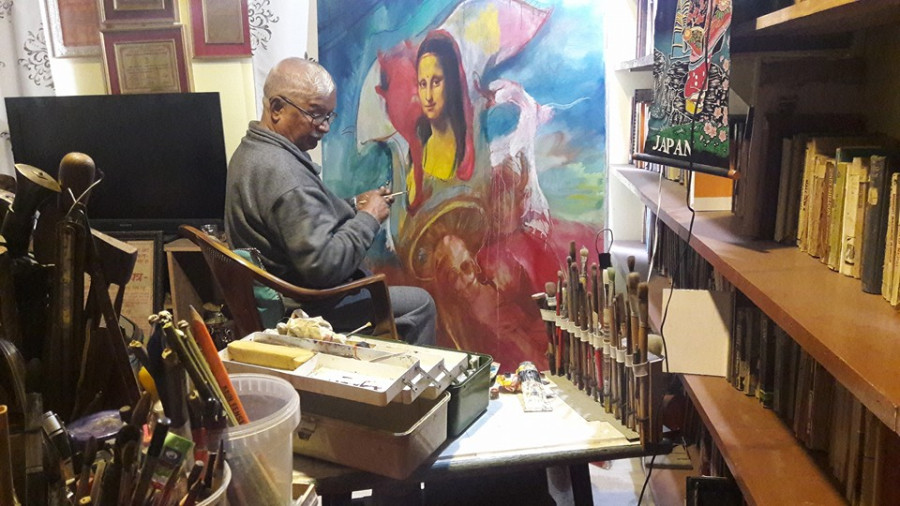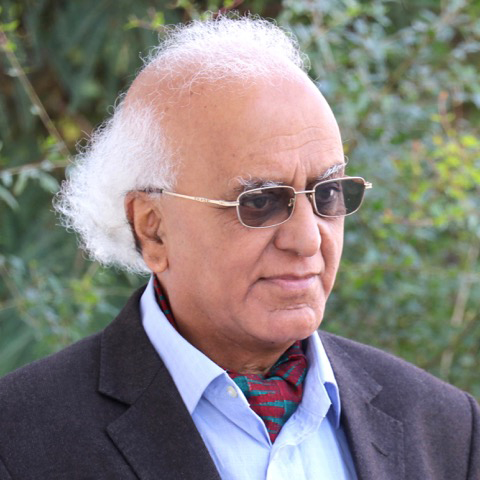Columns
Apocalyptic vision in Nepali art
The overall genius of modern Nepali paintings is one of calmness and hope rather than of ‘pralaya’.
Abhi Subedi
An academic working on the relation of arts and the sombre mood created by the pandemic questions—how do the Nepali painters respond to the mood of severe human crisis? His other question is about the spirit of such turmoil in modern Nepali paintings of the recent past and the present. These questions struck me because I had not seriously thought about the direct relation between serious crisis and paintings. It has become essential for all art lovers to look into this subject. The scholar's inquisition generates another crucial question—why can't the painters immediately respond to the challenging situation? This short article attempts to address these questions in the context of the grave situation created by the pandemic. This requires a lengthy discussion, which is not possible here.
Arts and literature are sensitive to serious events and changes, but as art and literature are aesthetic works, depicting the moments of crisis and unpleasant circumstances does not necessarily present a realistic picture of them instantaneously. As the practice of art would have it, it takes time for them to form ideas and create compositions about the crisis. The world of art and literature records the artists' creative responses to the events. But only sometimes do the events evoke the immediate reaction of the artists.
One example that people often cite is the mural painting of the Spanish born painter Pablo Picasso who visited Guernica, his native space destroyed by German bombing, and spontaneously painted the apocalyptic picture of the city's destruction. This mural became very popular in 1937 and 1939. The painting is one of the long-lasting pictures of a period of realistic action. Writers have also composed some literary impressions. But the process of depicting the horror or the dread of the war, pandemic or human misery uses some time to take shape. Why this happens like this is a subject of debate and contemplation.
There is no shortage of works of art in Nepal with an apocalyptic vision. But they are not necessarily propelled by a particular event of a specific time. It is not easy to find the right way to explain it. Here are some examples from modern Nepali paintings. The white stallions that the senior painter Sashi Shah paints in nearly most of his canvases are good examples. His stallion imagery reminds us of the prominent white horse in Picasso's oeuvre Guernica. Sashi Shah evokes the apocalyptic sense represented by the wild speed and mood of the stallion. But he prefers to call it the Kalki avatar of Bishnu of the Hindu pantheon, who takes that incarnation in what is imagined as our times to set the world in order.
This is one example of such paintings, especially of the abstract style that deals with the apocalypse or pralaya theme. But they depict the mood of the times experienced by humanity at large. We can discuss this subject by citing examples from modern Nepali paintings. Writing long articles in different issues of the Journal Sirjana edited by artist Navindra Man Rajbhandari, I have chosen abstract Nepali paintings that are so receptive to the mood of the times both in the depiction of distress and joy. I do not want to dwell on that here. But what I want to discuss is the nature of the artists' response to the disruptive order that is threatening our regular order of life like everywhere else.
Some young artists have depicted the state of horror. For that, they have chosen the motifs of fear and threat. That is the instantaneous response. But the imagination of the apocalypse exists in nearly all the significant works of art. The question we can ask is—can such works depict the situation of the pandemics that we are facing today? This is a significant question that art lovers and connoisseurs worldwide are asking now. Artists have always felt a certain sense of apocalypse or crisis in human existence and the times they live in. The famous method is that such works of art be evoked to depict the situation of the times. I want to refer to the imaginaire of crisis and hard times that some Nepali painters have depicted long before the present pandemic started.
Manujbabu Mishra's paintings overtly depict such times. I wrote earlier (Sirjana, 5:2018) that Manujbabu represents "distorted images such as the elongation of human forms." But he is drawn by the cubist style of Pablo Picasso. "By using blue and green, he creates the intense effect of human misery. Such paintings look almost monochromatic when he uses one colour predominantly." Another pioneering painter Lain Bangdel depicts human misery, especially in his early paintings that reveal the influence of Picasso's paintings of the blue period.
But Bangdel's abstract expressionist paintings and his portraitures are replete with warmth and love for humans and sentient beings. Uttam Nepali's thrust was always anthropomorphic; human beings appear with all their potentialities and love. As a portraitist, he does not distort the figurality of British painter Francis Bacon's famous portrait works. (The Kathmandu Post, August 1, 2021).
The other senior artists are the SKIB (Sashi Saha, Krishna Manandhar, Indra Pradhan and Batsagopal Vaidya). The overall mood of these painters is humanity and its various inclinations—from mythological to realistic nature. I have written about them in the same journal (Sirjana, 6:2019). Kiran Manandhar's paintings do not project any horrid semi-abstract images, his style. Ragini Upadhyay's intaglio works appear somewhat to be apocalypse savvy. They play with the fearful side of the figures from the legends and the artist's imagination.
Sashikala Tiwari's paintings with their figural treatments and pigments depict some apocalypse modes. Asmina Ranjit's paintings directly address the problematic human situation through lines and performative figurality. Based on my various articles and brochure texts were written about their artworks, I can say apocalyptic vision is depicted in them, except in the oeuvre of Manjubabu Mishra, with a great humanist idea of hope. Among the younger painters, I recall some works of Suman Chitrakar, Bidhata KC, Sushma Shakaya, Asha Dongol and others I have not found any direct use of apocalyptic vision. The overall genius of the modernist and modern Nepali paintings is one of calmness, hope and aesthetic joy rather than a mood of pralaya or apocalypse. But we have yet to see how the artists express the present crisis caused by the pandemics and disorders here and outside.




 18.12°C Kathmandu
18.12°C Kathmandu















